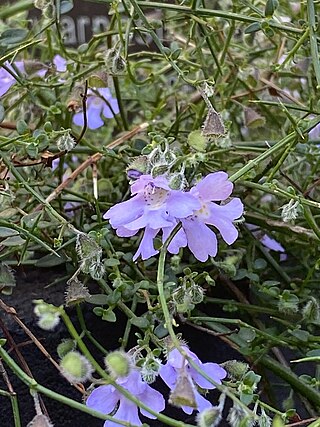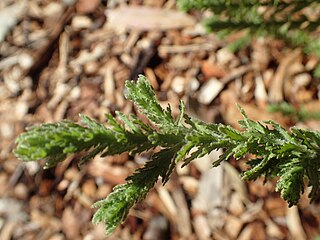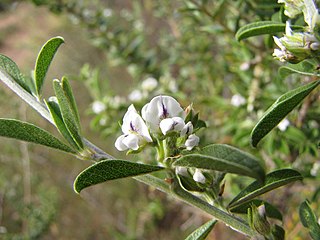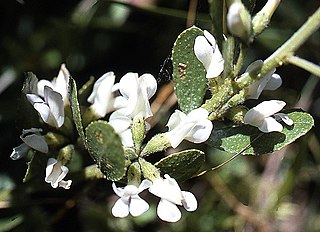
Pachypodium brevicaule is a species of plant that belongs to the family Apocynaceae.

Eurybia is a genus of plants in the family Asteraceae that were previously included in the genus Aster. Most species are native to North America, although one is also present in northern Eurasia. There are 23 species in the genus, including 1 natural hybrid. The name was first applied by Alexandre de Cassini in 1820. The name is derived from Ancient Greek εὐρύς (eurús), meaning "wide", and βαιός (baiós), meaning "few", perhaps in reference to the small number of relatively wide ray florets.

Prostanthera spinosa, commonly known as spiny mintbush, is a shrub that is endemic to south-eastern Australia. It has mauve to white flowers, spiny stems and aromatic foliage.

Eremophila pinnatifida, commonly known as Dalwallinu eremophila is a flowering plant in the figwort family, Scrophulariaceae and is endemic to Western Australia. It is a spreading, rounded shrub with aromatic, deeply divided leaves and pale purple flowers which are white with purple spots inside. It is a rare plant, known only from a few areas near Perth.

Petrophile axillaris is a species of flowering plant in the family Proteaceae and is endemic to southwestern Western Australia. It is a shrub with pinnately-divided, sharply-pointed leaves, and spherical heads of hairy pink or grey flowers.

Serruria elongata or long-stalk spiderhead is a plant belonging to the protea family. It is an erect, hairless shrublet of 1–1½ m (3½–5 ft) high with densely set, alternate, finely divided leaves lower down the plant, with needle-like segments. On top of an up to 30 cm (12 in) long inflorescence stalk are several, loosely arranged heads of pin-like, densely silvery-haired flower buds, each of which opens with four curled, magenta pink corolla lobes. The species is endemic to the southern Western Cape province of South Africa. It flowers during the southern hemisphere winter and early spring, between June and September.

Mairia crenata is a perennial herbaceous plant of mostly 2–15 cm (1–6 in) high that is assigned to the family Asteraceae. It has a woody rootstock of up to 5 cm (2 in) long, from which brown, fleshy roots develop. The five to eighteen, hard and leathery, spoon-shaped leaves are in one to three rosettes, have a distinct main vein, blunt or pointy tip, often dark red or blackish margins with rounded teeth and a ½–2 cm (0.2–0.8 in) long stalk-like foot, often initially somewhat woolly hairy, on particularly the lower surface and the main vein, but this is easily rubbed off the shiny surfaces. Each rosette produces mostly one, sometimes up to four, mostly rusty or whitish woolly hairy, brown or dark red inflorescence stalks, usually 1½–15 cm long, each with two to eight, initially woolly, line-shaped to oval bracts, the lowest up to 3 cm (1.2 in), decreasing size further up, and carrying mostly one, rarely up to three flower heads. The flower heads have a bell-shaped involucre with about 40 bracts, sixteen to thirty three violet to white ray florets of about 1¼–1⅞ cm long, and many yellow disc florets. The species flowers anywhere between February and December but only after a fire has destroyed the overhead biomass or serious disturbance. It is an endemic species that is restricted to the Eastern Cape and Western Cape provinces of South Africa.

Tephrosia glomeruliflora, or pink tephrosia, is a perennial (non-climbing) herb in the family Fabaceae, endemic to South Africa. It is also found on the eastern coast of Australia, in New South Wales and Queensland, where it is considered an environmental weed.

Mairia coriacea is a perennial plant assigned to the family Asteraceae. It has broad, tough and leathery, evergreen leaves. These have a narrowed foot and an entire margin or a few shallow, irregular teeth. They grow in a rosette directly from the rootstock. The plant produces flower heads with one whorl of white to mauve ray florets around many yellow disc florets, with one or few on top of a dark reddish, woolly stalk. Flower heads appear after the overhead vegetation burnt down, often destroying the leaves in the process. It can be found in the southern mountains of South Africa's Western Cape province. It is called leather leaves in English.

Mairia petiolata is a tufted, variably hairy, perennial plant of up to 15 cm (6 in) assigned to the family Asteraceae. Its leaves are in a ground rosette, and have a stalk of mostly 2–5 cm long and an inverted egg-shaped to elliptic, 61⁄2–9 cm (2.6–4.6 in) long and 2–3 cm wide leaf blade, with a toothed margin. It mostly has two flower heads at the tip of the branches of each erect, dark reddish brown scape. The flower heads have a bell- to cup-shaped involucre that consists of 20–24, purplish, overlapping bracts in 3–4 whorls. These protect 12–16 pink, ray florets, surrounding many yellow disc florets. This species was only seen flowering once, in December. It is known from one location in the Langeberg, Western Cape province of South Africa.

Mairia hirsuta is a tufted perennial, herbaceous plant of up to 40 cm high, that is assigned to the family Asteraceae. Most of its narrow to broad elliptic or inverted egg-shaped leaves are part of the basal rosette, have margin that is rolled under, with rounded or pointy teeth or with some peg-like extensions, lightly woolly on the upper surface and densely woolly on the underside, but always the green remains visible. Flower heads have been found from July to November, mostly after a fire or when the soil has been disturbed. The species can be found in the southern mountains of the Western Cape province of South Africa.

Otholobium nitens is an upright, densely branched shrub of up to 1.5 m high that is assigned to the Pea family. It has one to many initially softly hairy stems, alternately set, clover-like, upright leaves crowding the new shoots, and heads consisting of 3 pea-like, dark purple to mauve flowers on short peduncles in the axils of the leaves on short side-shoots. This species is an endemic of the mountains between Ceres and Hottentots Holland in the Western Cape province of South Africa. It mostly flowers between October and late December.

Otholobium spissum is a dense, tangled, much branched shrub of up to 185 cm (73 in) high that is assigned to the Pea family. It has dull green, clover-like leaves and white, pea-like flowers with a streaky, triangular, purple nectar guide. The species grows in renosterveld in the central mountains of the Western Cape province of South Africa. This species flowers in July and August.

Otholobium lanceolatum is a small subshrub of up to 20 cm (7.9 in) high, that is assigned to the Pea family. It has up to 7 horizontal stems with raised tips, few hairless, alternately set leaves with only one leaflet and clusters of 15-27 white, pea-like flowers with a purple tip near the top of the short, seasonal shoots. It is endemic to one site near Caledon, South Africa. Flowers only appear in November and December within one year after a fire destroyed the vegetation.

Otholobium lucens is a shrub of up to 60 cm (24 in) high that is assigned to the pea family. It has alternately set clover-like leaves crowding on the new growth, while older parts have lost their leaves. The white, pea-like flowers occur with 3 or 6 together in the leaf axils. This rare species is an endemic of the Swartberg mountains in the Western Cape province of South Africa. It flowers between July and February.

Pseuduvaria setosa is a species of plant in the family Annonaceae. It is native to Peninsular Malaysia. George King, the botanist who first formally described the species under the basionym Orophea setosa, named it after the bristly hairs on its leaves and petioles.
Rachelia is a monotypic genus of flowering plants belonging to the family Asteraceae. It just contains one species, Rachelia glariaJ.M.Ward & Breitw. It is in the tribe Gnaphalieae.

Babiana tubiflora is a species of geophyte of 7–15 cm (2.8–5.9 in) high that is assigned to the family Iridaceae. It has whitish mirror-symmetrical flowers with a long narrow tube that split into six tepal lobes, have three stamens, and line- to lance-shaped, laterally compressed leaves. It is an endemic species of South Africa that can be found along the west and south coast of the Western Cape province. It flowers from August to early October.
Athanasia grandiceps is a species of plant from South Africa. It belongs to the daisy family.
Dicoma swazilandica is a species of plant from Eswatini and South Africa.
















